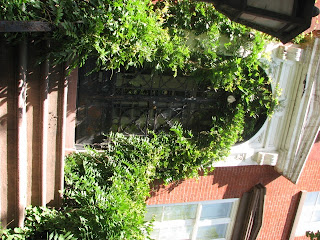
Splendid Encampment
By David Crohn
Faced with interrogating the inanimate, teasing the hidden life from buildings and streets—at least half of which happens behind closed doors—is daunting. It takes time, patience and an open mind.
Seldom, as I’m sure anyone can imagine, does anything notable simply step up and present itself. You have to talk to people who know better, peer through windows and doors. Sometimes you have to squint to make the pieces fit.
All of this is a given, every time. I am reminded whenever I explore a new block. When things go well the pain is less acute; by some imprecise magic, I squeeze the stone, and blood comes out.
But this block—so lush, and largely uniform—seems impenetrable. Rowhouse after rowhouse after rowhouse—each three stories high. Why? And why does the name Leroy Street end right where the street bends, only to pick up again west of Hudson?
Andy Warhol and Steve Reich taught us the hypnotic beauty of repetition, but I doubt that’s what the 19th century builder had in mind for the stretch of 15 rowhouses that, for many, defines St. Luke’s Place and Leroy Street between Seventh Ave. South and Hudson Street.
We know that back then it wasn’t uncommon to rename a portion of a block to boost its putative prestige. Which is what Trinity Church, which owned all the land here, did before selling it all off starting in 1851. (The 15 residences along St. Luke’s Place are numbered sequentially.)
Christopher Gray, writing in the New York Times in 1996, calls the swath of homogeny “a mystery of 19th-century real-estate development in New York: who or what was the common agent that produced such a uniform row?” He didn’t know then, and my research turned up nothing better. But whoever it was, they liked brick and brownstone. They wielded a top-notch cookie cutter, aesthetically speaking, using the Renaissance and Greek Revival styles popular with the upper crust at the time.
At Seventh Avenue South and Leroy Street, things aren’t nearly so pretty, or so clean. The end of St. Luke’s Place is marked by apartment buildings that suddenly tower over their neighbors; go further around the corner, north along Seventh Ave. South, and trash litters the sidewalk. There’s graffiti, and across the street, a vacant storefront.
But for the splendidly encamped residents of St. Luke’s Place, the trees and the turn protect their niche. The Greeks had a special name for the revelatory twist—chiasmus—and it is through that convolution that the blood of this block pumps.
Living Here
The quick and easy way to move to this pricey block would be through 9300 Realty or CitiHabitats. The former has a fifth-floor walk-up studio apartment available at 53 Leroy ($2,395 a month), and the latter handles rentals next door at 51. A quick call to CitiHabitats revealed that nothing was available at press time; but they leave their sign up, a nod to frequent vacancies for the young professionals and students who tend to make up the majority of their clientele.
Amenities
The block is strictly residential, but its neighboring stretch of Hudson Street is home to the Candy Café, a retro-style eatery; Out of the Kitchen, for semi-gourmet takeout; and a mini-grocery store.
What Happened Here
Maybe it’s the location. Maybe it’s the regality of those rowhouses. Either way, St. Luke’s Place has a history replete with prominent former residents: former Mayor James J. Walker (1926-1932), for whom the park across the street, formerly a cemetery, is named. (Note the so-called “mayoral lampposts” at number 6.) Also, Theodore Dreiser, Sherwood Anderson and Timothy Leary. TV’s Cosby family may have lived in Brooklyn, but the exterior to their home was shot at 10 St. Luke’s Place.
My favorite though is the playful poet Marianne Moore, who made Modernism charming while living at “14 St. Luke’s Place when she first moved to New York City.” So says the plaque across the street, next door to the Hudson Park branch of the New York Public Library where she worked. Moore wore a tricorn hat and black cape to boxing matches, wrote to the Ford Motor Company suggesting the name “Utopian Turtletop” for the car that would become the Edsel, and wrote in her poem “To a Snail,” which could have been called “To St. Luke’s Place”: “It is not the acquisition of any one thing/that is able to adorn/or the incidental quality that occurs/as a concomitant of something well said,/that we value in style,/ but the principle that is hid…”
dcrohn@gmail.com
No comments:
Post a Comment